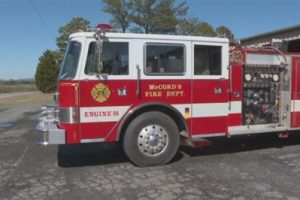Table of Contents
Learn how volunteer firefighting works and the important role it plays in communities. Discover the training, responsibilities, and equipment involved in volunteering as a firefighter. Explore the benefits of becoming a volunteer firefighter and how you can make a difference by joining this noble endeavor.
Volunteer firefighting is a remarkable and selfless endeavor that plays a vital role in ensuring the safety and well-being of communities across the globe. With its roots dating back centuries, this noble profession relies on the unwavering dedication of individuals who willingly put themselves in harm’s way to protect others. So, how exactly does volunteer firefighting work? In this article, we will delve into the inner workings of this noble vocation, exploring the recruitment process, training requirements, and the day-to-day responsibilities that make these brave men and women indispensable pillars of their communities.
The Importance of Volunteer Firefighting
Volunteer firefighting plays a crucial role in communities across the country. These brave individuals dedicate their time, energy, and skills to protect their neighbors and property from the dangers of fires. While they may not receive a paycheck for their efforts, their commitment and selflessness make them an invaluable asset in emergency situations.
The Duties and Responsibilities of a Volunteer Firefighter
Volunteer firefighters have a wide range of responsibilities that go beyond just fighting fires. They undergo extensive training to handle various emergency situations, such as medical emergencies, hazardous material incidents, and vehicle accidents. In addition to responding to emergencies, they also participate in community outreach programs, fire prevention education, and regular maintenance of firefighting equipment.
Recruitment and Training Process
Volunteer fire departments actively recruit individuals who are willing to serve their communities. The recruitment process typically involves an application, background check, and an interview. Once selected, volunteers undergo comprehensive training, which includes both classroom instruction and practical hands-on exercises. They learn firefighting techniques, search and rescue procedures, first aid, and how to operate firefighting equipment.
Volunteer Firefighting Equipment
While volunteer firefighters may not have access to the same resources as full-time, professional departments, they are equipped with the necessary tools to perform their duties effectively. This includes personal protective gear, such as helmets, gloves, and turnout gear, as well as firefighting equipment like hoses, nozzles, and axes. The equipment is regularly inspected and maintained to ensure its proper functioning during emergencies.
On-Call Availability
One of the key aspects of volunteer firefighting is being on-call. Volunteers are typically required to be available during certain hours or days of the week, ready to respond to emergency calls at a moment’s notice. Some departments also utilize pager systems or mobile apps to notify volunteers of emergencies. This level of availability allows for a quick response and ensures that help is always just a phone call away.
The Benefits of Volunteer Firefighting
Becoming a volunteer firefighter has numerous benefits beyond the satisfaction of helping others. It offers an opportunity to learn valuable life skills, such as teamwork, leadership, and problem-solving. Volunteer firefighters also receive extensive training in emergency medical services, which can benefit them in their personal lives or future careers in the healthcare field. Additionally, volunteering can foster a strong sense of camaraderie and community among fellow firefighters.
Challenges Faced by Volunteer Firefighters
Despite the many rewards, volunteer firefighters also face certain challenges. Juggling their commitment to firefighting with personal and professional responsibilities can be demanding. They often sacrifice their time, as emergencies can occur at any moment. Additionally, fundraising and securing necessary resources can be a continuous challenge for volunteer fire departments, as they heavily rely on community support to maintain operations.
The Impacts of Volunteer Firefighting
Volunteer firefighting has a profound impact on individuals, communities, and society as a whole. The dedication and bravery of these volunteers ensure the safety and well-being of their neighbors. By responding swiftly to emergencies, they save lives, protect property, and provide critical support to professional fire departments. Their involvement in fire prevention and education programs also helps create a safer community by raising awareness and reducing the risk of fires.
Becoming a Volunteer Firefighter
If you are interested in becoming a volunteer firefighter, reach out to your local fire department. They will provide you with information about the recruitment process, training requirements, and any specific qualifications needed. Remember, volunteer firefighting is a noble and rewarding endeavor that allows you to make a significant difference in the lives of others and your community as a whole.
Conclusion
Volunteer firefighting is an integral part of emergency response systems, providing essential support to professional fire departments. Through recruitment, training, and the availability of dedicated volunteers, communities can rely on a prompt response in times of crisis. Despite the challenges faced by volunteer firefighters, their commitment and selflessness make them true heroes who protect lives and property without expecting anything in return.
How Does Volunteer Firefighting Work
Volunteer firefighting plays a crucial role in ensuring the safety and well-being of communities across the country. These dedicated individuals selflessly donate their time and energy to protect lives and property from the devastating effects of fires and other emergencies. Understanding how volunteer firefighting works can provide valuable insight into the challenges and rewards associated with this noble profession.
Recruitment and Training
Volunteer fire departments actively recruit members from their local communities who have a desire to serve. These departments may advertise through various channels, including local newspapers, community events, and social media platforms. Once prospective volunteers express their interest, they undergo a rigorous selection process that typically includes interviews, background checks, and physical fitness assessments.
Accepted recruits then embark on an extensive training program designed to develop essential skills required for firefighting and emergency response. This training covers a wide range of topics, including fire suppression techniques, first aid and CPR, hazardous materials handling, and equipment operation. By the end of the training, volunteers are equipped with the knowledge and skills necessary to effectively respond to emergency situations.
Alarms and Dispatch
When an emergency call comes in, volunteer firefighters are alerted through a pager system or mobile app. These alerts provide information about the nature of the emergency and its location, allowing volunteers to respond promptly. Upon receiving an alert, volunteers quickly organize themselves, gear up, and either head to the fire station or directly to the incident scene, depending on the department’s protocols.
Response Time and Incident Management
Volunteer firefighters strive to achieve the fastest possible response time to emergency incidents. However, since they may not be stationed at the firehouse, they often rely on their personal vehicles to reach the location quickly. Once on the scene, they follow an incident management system, which includes assigning roles and working collaboratively to mitigate the emergency.
Effective incident management is crucial for ensuring a coordinated and efficient response. Clear communication channels are established, and volunteers work together to assess the situation, implement appropriate tactics, and prioritize the safety of both the public and themselves. This collaborative approach allows for a well-organized and effective firefighting operation.
Collaboration with Career Firefighters
In many areas, volunteer and career firefighters work hand in hand to provide comprehensive emergency response services. Career firefighters are typically responsible for handling larger or more complex incidents, while volunteers assist with initial response, support functions, and filling in any gaps in coverage during busy periods.
This collaboration between volunteer and career firefighters ensures that emergencies are handled efficiently and effectively. By combining their expertise and resources, these two groups create a powerful force capable of responding to a wide range of emergencies and providing optimal assistance to those in need.
Scheduling and Availability
Volunteer firefighters often have other full-time jobs or commitments, making scheduling a challenge. To address this, some departments utilize shift-based systems, where volunteers are assigned specific shifts similar to those of career firefighters. Other departments rely on members to sign up for specific time slots on a voluntary basis, allowing them to choose shifts that fit their availability.
In addition to emergency response duties, volunteer firefighters are also required to attend regular training sessions and participate in maintenance activities to ensure their skills remain sharp and equipment remains in top condition. These non-emergency activities are often scheduled based on member availability to accommodate their personal and professional responsibilities.
Equipment and Facilities
Volunteer fire departments heavily rely on local funding, grants, and donations to acquire and maintain their firefighting apparatus, protective gear, and facilities. They often hold fundraisers, such as pancake breakfasts or community events, to generate funds. Additionally, they actively apply for grants from government agencies and non-profit organizations to secure the necessary financial resources.
Ensuring that volunteers have access to high-quality equipment is essential for their safety and effectiveness. Firefighting apparatus, such as fire engines and ladder trucks, are expensive investments, and volunteer departments must carefully allocate their limited resources to acquire and maintain these crucial assets. Similarly, protective gear, including helmets, turnout gear, and breathing apparatus, must meet stringent safety standards to protect firefighters from the hazards they may encounter in the line of duty.
Community Involvement and Education
Volunteer firefighters play a vital role in engaging with their communities beyond emergency response. They actively participate in community outreach programs, public education events, and fire prevention campaigns. These initiatives aim to raise awareness about fire safety, educate the public on emergency preparedness, and establish strong relationships between firefighters and the communities they serve.
Volunteers often provide interactive demonstrations on fire safety practices, offer guidance on creating evacuation plans, and share valuable information on how to prevent fires and other emergencies. They also participate in local festivals, parades, and school visits, where they showcase their firefighting equipment and engage with community members of all ages.
Rewards and Challenges
Volunteer firefighting offers numerous rewards and challenges. One of the most significant rewards is the satisfaction of helping others and making a positive impact on the community. Volunteer firefighters have the opportunity to save lives, protect property, and provide support during times of crisis.
Moreover, volunteer firefighting allows individuals to develop valuable skills and knowledge through comprehensive training programs. They gain expertise in various areas, including firefighting techniques, emergency medical response, and incident management. This personal growth not only enhances their abilities as firefighters but also equips them with valuable life skills.
However, volunteer firefighting also comes with challenges. Balancing personal life with emergency response duties can be demanding, especially for volunteers who have full-time jobs or families. The unpredictable nature of emergencies means that volunteers must always be prepared to respond, even during inconvenient times.
Furthermore, volunteer firefighters are exposed to physical and emotional risks while facing danger to protect their communities. They may encounter hazardous environments, extreme temperatures, and stressful situations that require quick decision-making. It is crucial for volunteers to undergo ongoing training and support to ensure their well-being and resilience in the face of these challenges.
In conclusion, volunteer firefighting operates through a well-structured system that involves recruitment, training, effective response, collaboration, scheduling, equipment acquisition, community involvement, and managing the rewards and challenges associated with the profession. The dedication and commitment of volunteer firefighters play an integral role in preserving the safety and security of communities, showcasing the power of individuals coming together to make a difference.
Point of View: How Does Volunteer Firefighting Work?
Introduction
- Volunteer firefighting is a crucial aspect of ensuring public safety and fire prevention in communities across the world.
- Understanding how volunteer firefighting works can provide insight into the dedication, training, and commitment required for these selfless individuals to protect lives and property.
The Role of Volunteer Firefighters
- Volunteer firefighters play an essential role in assisting professional fire departments in responding to emergencies.
- They are responsible for responding to various incidents, including structure fires, medical emergencies, hazardous material spills, and natural disasters.
- Volunteers often serve as the first line of defense until professional firefighters arrive on the scene.
Recruitment and Training
- Volunteer fire departments actively recruit individuals who are passionate about serving their communities and willing to undergo rigorous training.
- Training typically includes learning firefighting techniques, first aid and CPR, equipment operation, rescue procedures, and incident command system protocols.
- Volunteers must commit to regular training sessions and maintain certifications to ensure they are prepared to handle emergency situations effectively.
Availability and Response
- As volunteers, firefighters have other jobs or obligations outside of their firefighting duties.
- They are typically on-call or respond to emergencies when available, depending on their individual schedules.
- Volunteer fire departments often have a system in place to ensure a sufficient number of firefighters can respond to emergencies promptly.
Equipment and Funding
- Volunteer fire departments rely on funding from various sources, including local government support, grants, private donations, and fundraising efforts.
- Acquiring and maintaining firefighting equipment, such as fire trucks, protective gear, and medical supplies, is essential for volunteer departments to effectively carry out their duties.
Collaboration with Professional Fire Departments
- Volunteer firefighters often work closely with professional fire departments to ensure seamless coordination during emergencies.
- They assist by providing initial firefighting efforts, establishing perimeter control, managing traffic, and offering support to professional firefighters as needed.
- Collaboration between volunteers and professionals strengthens the overall emergency response capabilities within a community.
Rewards and Challenges
- While volunteer firefighting can be immensely rewarding, it also comes with its fair share of challenges.
- Volunteers face physical risks, emotional strain, and time commitments while balancing their personal lives and careers.
- However, the sense of accomplishment, camaraderie, and the opportunity to make a positive impact on the community are among the many rewards of being a volunteer firefighter.
Conclusion
- Volunteer firefighting operates on the dedication and selflessness of individuals who give their time and energy to protect their communities.
- Understanding the inner workings of volunteer firefighting highlights the importance of supporting and appreciating these brave men and women who serve as the backbone of public safety.
Thank you for taking the time to read this article on how volunteer firefighting works. We hope that this information has given you a better understanding of the important role that volunteer firefighters play in our communities. As you have learned, volunteer firefighting is a crucial and selfless act that requires dedication, training, and teamwork.
Volunteer firefighters are individuals who choose to give their time and effort to protect and serve their communities. They undergo extensive training to develop the necessary skills and knowledge required to respond to emergencies effectively. From learning how to operate firefighting equipment to understanding fire behavior and rescue techniques, these dedicated individuals invest countless hours into their training.
When an emergency call comes in, volunteer firefighters must be ready to drop everything and respond. They work alongside their fellow firefighters, both volunteer and professional, to extinguish fires, rescue trapped individuals, provide medical assistance, and ensure the safety of the community. It is through their courage and commitment that lives are saved and property is protected.
In conclusion, volunteer firefighting is a vital service that relies on the generosity and selflessness of individuals who are willing to put themselves in harm’s way for the well-being of others. These brave men and women dedicate their time and energy to ensure that their communities are safe and protected. They undergo rigorous training, respond to emergencies, and work as a team to save lives and property. Without their contributions, our communities would be at a significant disadvantage in the face of fires and other emergencies. So, let us express our gratitude and admiration for these unsung heroes who embody the true spirit of volunteerism.
Thank you once again for reading this article, and we hope it has shed light on the incredible work of volunteer firefighters. If you have any questions or would like to learn more about how you can support your local volunteer fire department, please reach out to them directly. Together, we can all contribute to the safety and well-being of our communities.
.
How Does Volunteer Firefighting Work?
Volunteer firefighting is a crucial component of emergency response systems in many communities. Here are some common questions people have about how volunteer firefighting works:
What does it mean to be a volunteer firefighter?
How do volunteer firefighters get trained?
What are the requirements to become a volunteer firefighter?
How do volunteer firefighters respond to emergencies?
Do volunteer firefighters only fight fires?
How do volunteer firefighters balance their duties with other commitments?
Being a volunteer firefighter means offering your time and skills to serve your community in times of emergency. Volunteer firefighters undergo training and perform firefighting duties without receiving monetary compensation.
Volunteer firefighters receive training through fire academies, local fire departments, or specialized training centers. They learn essential firefighting techniques, search and rescue methods, first aid, hazardous materials handling, and other necessary skills to ensure their effectiveness in emergency situations.
The specific requirements vary depending on the jurisdiction, but generally, individuals must be at least 18 years old, have a high school diploma or equivalent, possess a valid driver’s license, and pass a background check. Some areas may also require physical fitness tests.
When an emergency call is received, volunteer firefighters promptly report to the fire station. They quickly don their protective gear, board the fire apparatus, and rush to the scene of the incident. Once there, they work alongside professional firefighters to extinguish fires, provide medical assistance, and ensure public safety.
No, volunteer firefighters are trained to handle a wide range of emergency situations. In addition to fighting fires, they assist in medical emergencies, perform search and rescue operations, respond to hazardous material incidents, conduct public education programs, and participate in community events to promote fire safety.
Volunteer firefighting requires dedication and flexibility. Many volunteers have regular jobs or other commitments, so they coordinate their availability with the fire department. They may be on-call during specific shifts or respond to emergencies when they are available, ensuring that the community has round-the-clock coverage.
Volunteer firefighters play a vital role in safeguarding communities, and their commitment to service is commendable. Their selflessness and willingness to protect lives and property make them an invaluable asset in emergency response efforts.






